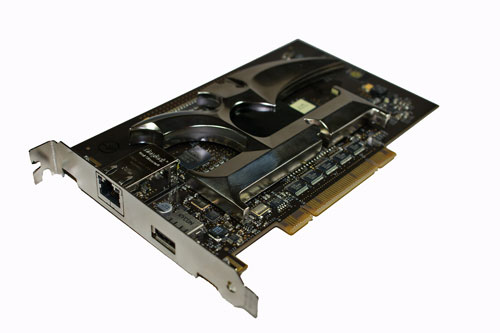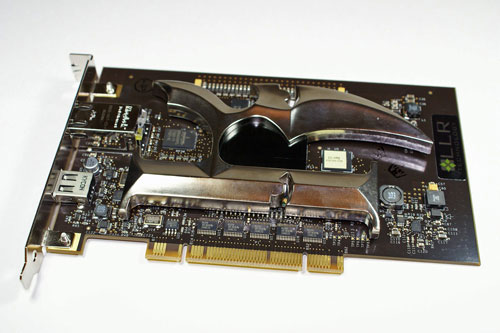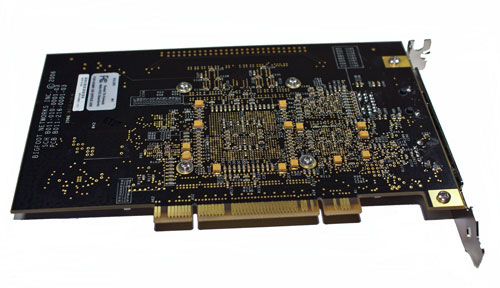BigFoot Networks Killer NIC: Killer Marketing or Killer Product?
by Gary Key on October 31, 2006 2:00 AM EST- Posted in
- Networking
Killer NIC Card
The Killer NIC ships with an installation disc that includes several Linux programs, a few decals, product documentation package, and a full retail copy of F.E.A.R. on DVD.
The Killer NIC is a very interesting card and since the Halloween season is upon us we have to say the thought of removing the "K" heatsink and using it as part of our Blade costume came to mind several different times. The PCB is black in color and contains a significant amount of components that you would never expect to see on a typical NIC. There are also several red LEDs on the PCB whose blinking movements can be adjusted by the control panel. Overall, the card's design theme follows its naming convention.
The card is equipped with a Freescale MPC8347E communications processor, a Xilinx Spartan FPGA, an integrated Broadcom Gigabit PHY, and 64MB of RAM for the embedded Linux build that is accessed by the FNapp Console. The Freescale MPC8347E communications processor is designed for general communications requirements from Ethernet routers to Internet network appliances. The Xilinx Spartan FPGA is a programmable gate array that houses Bigfoot Networks' proprietary and patent pending algorithms that also utilize the 64MB of onboard RAM.

The card utilizes a standard RJ-45 port and includes a USB 2.0 port. The USB 2.0 port is not visible to Windows and is designed to be used by an FNapp. The thought process is that an FNapp can read or write data to a flash drive or external HD. This would be very advantageous for writing data directly to an external hard drive via a BitTorrent type FNapp as one example.
The amount of integrated components along with its basic design features is one of the reasons why this card costs $279.99. This is a price tag that generally puts this card out of reach for most users who are typically satisfied with their NIC's current performance.
The card was very easy to set up. You need to disable your current NIC for optimum performance and compatibility. This is an action that we highly advise after a couple of aborted installs with the original driver set. The card requires a single PCI 2.2 slot and is only compatible with 32-bit Windows XP at this time. After installing the card, a quick reboot, and hardware recognition by XP, you install the driver set off the CD although we highly suggest downloading the latest release first. Another reboot is required and then you are set to use the card for total world domination. Well, at least this is probably your thought process if you read through the marketing material and other documentation online.
Additional 64-bit XP and Linux support is expected within the next six to eight weeks. However, it is still uncertain as to what features will be enabled for Linux and what if any performance benefits will be gained. Windows Vista support should be available by the time the OS ships and it will be interesting to see if there are any improvements considering Microsoft has completely rewritten the network stack code for efficiency and latency reduction. At this point in time there are no plans for a PCI Express version of the Killer NIC. According BigFoot Networks the PCI interface was utilized to improve transactional latencies, programming familiarity, and the fact that most systems have the required amount of PCI slots. We disagree with that last point as the majority of performance oriented boards are now PCI slot starved, and we would expect PCI-E to be a future consideration depending on the success of the current design.
The Killer NIC ships with an installation disc that includes several Linux programs, a few decals, product documentation package, and a full retail copy of F.E.A.R. on DVD.
 |
 |
| Click to enlarge |
The Killer NIC is a very interesting card and since the Halloween season is upon us we have to say the thought of removing the "K" heatsink and using it as part of our Blade costume came to mind several different times. The PCB is black in color and contains a significant amount of components that you would never expect to see on a typical NIC. There are also several red LEDs on the PCB whose blinking movements can be adjusted by the control panel. Overall, the card's design theme follows its naming convention.
The card is equipped with a Freescale MPC8347E communications processor, a Xilinx Spartan FPGA, an integrated Broadcom Gigabit PHY, and 64MB of RAM for the embedded Linux build that is accessed by the FNapp Console. The Freescale MPC8347E communications processor is designed for general communications requirements from Ethernet routers to Internet network appliances. The Xilinx Spartan FPGA is a programmable gate array that houses Bigfoot Networks' proprietary and patent pending algorithms that also utilize the 64MB of onboard RAM.

The card utilizes a standard RJ-45 port and includes a USB 2.0 port. The USB 2.0 port is not visible to Windows and is designed to be used by an FNapp. The thought process is that an FNapp can read or write data to a flash drive or external HD. This would be very advantageous for writing data directly to an external hard drive via a BitTorrent type FNapp as one example.
The amount of integrated components along with its basic design features is one of the reasons why this card costs $279.99. This is a price tag that generally puts this card out of reach for most users who are typically satisfied with their NIC's current performance.
The card was very easy to set up. You need to disable your current NIC for optimum performance and compatibility. This is an action that we highly advise after a couple of aborted installs with the original driver set. The card requires a single PCI 2.2 slot and is only compatible with 32-bit Windows XP at this time. After installing the card, a quick reboot, and hardware recognition by XP, you install the driver set off the CD although we highly suggest downloading the latest release first. Another reboot is required and then you are set to use the card for total world domination. Well, at least this is probably your thought process if you read through the marketing material and other documentation online.
Additional 64-bit XP and Linux support is expected within the next six to eight weeks. However, it is still uncertain as to what features will be enabled for Linux and what if any performance benefits will be gained. Windows Vista support should be available by the time the OS ships and it will be interesting to see if there are any improvements considering Microsoft has completely rewritten the network stack code for efficiency and latency reduction. At this point in time there are no plans for a PCI Express version of the Killer NIC. According BigFoot Networks the PCI interface was utilized to improve transactional latencies, programming familiarity, and the fact that most systems have the required amount of PCI slots. We disagree with that last point as the majority of performance oriented boards are now PCI slot starved, and we would expect PCI-E to be a future consideration depending on the success of the current design.










87 Comments
View All Comments
Gary Key - Wednesday, November 1, 2006 - link
We tested these two cards as part of our Killer NIC testing routine. We did not report the numbers as they did not vary greatly from the NIVIDA 590SLI NIC solution.Crassus - Wednesday, November 1, 2006 - link
Sorry, but that plus the server test would have been very useful information I would have liked in the review. Or maybe we can have a different review, sort of a "NIC roundup". If your results are the same across the board, it's a finding worth mentioning as well, isn't it?Frumious1 - Tuesday, October 31, 2006 - link
I bet it doesn't even beat the onboard NVIDIA NIC. Or rather, it will tie the NVIDIA solution, which means it's equal to the Killer in most situations and fractionally slower in a few games. Maybe it has lower CPU usage when doing gigabit transmits, but high bandwidth with low CPU usage isn't going to matter much for gaming. Not that any NIC related stuff matters much for gaming these days.vaystrem - Tuesday, October 31, 2006 - link
I agree its very difficult to test NIC performance and kudos to Anandtech for trying. But, it seems to me that using the card as a server for the games where it saw the most improvement, Fear/CS, and even for those that it didn't may be more enlightening than exploring the client side of things.Gary Key - Tuesday, October 31, 2006 - link
We set up one of our test beds as a server for a couple of the games we tested. The performance was actually worse than our NVIDIA NIC (dualnet/teaming), Intel PRO/1000 PT, and barely did better than our D-Link PCI NIC in half of the tests. We will not fault the card for its peformance since it was specifically designed as a client side card. This very well could change in the future due to their ability to optimize driver code on the FPGA unit. The article could have gone another five pages with the server and LAN tests that we completed (neither showed any significant differences). It appears from several of the comments that anything over three pages was a waste anyway. ;-)EODetroit - Tuesday, October 31, 2006 - link
Except according to the PR material the card is made for game clients, not optimized for game servers.VooDooAddict - Tuesday, October 31, 2006 - link
While the POSIBILITY of embeded linux apps is interesting. For someone who would have the $$ do buy this ... they would have the money to put inexpensive PC parts together into a linux machine. Likely they have spare parts leftover from thier last upgrade.Anyone else think the company name is strangly fitting? "BigFoot" ... Myth and Hype?
Certainly not saying a nice NIC isnt'a good investment ... but at almost $300 ... it's a joke. Drop the embedded linux, hit the $50 price point and this thing would probably sell like mad to WoW Addicts. (eventually also have a PCIe version)
The aegia(sp?) physics processor is the same way. Great concept, but the tangable benefits are so minimal for the price. $300 Video cards took off because there was a tangable benefit.
Dropping anothre $300 into the Storage System, Monitor, CPU, Video card, RAM, or even Audio system (surround speakers) would give one a much mroe imersive experience.
Someone made the wrong decission to stick with the embedded linux thing. Seriously a sperate leftover parts Linux box and a DLINK 4100 router would be a far better way to go.
So any guesses as to the next $300 (*caugh* gimic *caugh*) expendature to "improve" gaming?
For those comparing this to SLI/Crossfire. SLI and Crossfire can offer substantial image quality enhancements for people with large pixel count LCDs. The ability to run LCDs at native resolution for gaming is a very tangable benefit. Not something everyone agrees it worth the $$. But the benefit is there.
VooDooAddict - Tuesday, October 31, 2006 - link
I was really hoping for somethign major from this card ... just from the perspective of reliving history.Around 10 years ago now (back around '96-'97) when NICs weren't build onboard spending $60-$70 on a 3Com 3c905 or a server class Intel NIC would make a bug differance in overall system performace when working with the Internet, LAN, and Gaming. They gave me big advantages over anyone who just went out an bought a cheapo $20 NE2000 comptable NIC (16-bit ISA even!).
I'm talking Quake 1, Duke3D, Quake 2, Quake CTF, Original Unreal... A single 3dFx VooDooGraphics Board + 3c905 = pwnage (back when "pwnage" was still a typo). I was so often accused of cheating by laptop wielding, software emulating, newbies (wasn't spelt "noob" then).
... That above is why I picked up the handle "VooDooAddict"
EODetroit - Tuesday, October 31, 2006 - link
And they deleted it. Claiming it needed to be moved from "Testimonials" to "General" forum. Whatever, but they didn't actually move my post, they deleted it and replaced it with a post of their own, with the link, plus quoted all the good things said in the Anandtech review and none of the bad. Typical and misleading, but hey, its their web site. They can do what they want. Still, misleading people doesn't endear them to anyone.LoneWolf15 - Tuesday, October 31, 2006 - link
I admire the amount of engineering that went into this product. It's obvious that the product isn't "snake oil" in the same way that, say, SoftRAM software was back in the day. There's a lot more to this card than just a NIC.That said, I don't think it provides enough benefit to justify $279 (unless perhaps you're making $50k+ a year in the PGL). Today's NICs are already pretty well optimized for most situations, plus many mainboard NICS are directly on the PCIe bus, something the Killer NIC can't offer (and as someone pointed out, try doing gig ethernet across a PCI slot; it really isn't feasible, especially if you already have the PCI bus shared with other components like a TV tuner or sound card). The Killer NIC's most interesting feature, FNApps, is not useful at the moment, and I'm still concerned that it might pose a security risk through a malformed application (that's assuming someone coded that app in the first place, considering how little marketshare the Killer NIC is likely to have). Like the Ageia PhysX, at this point in time, I don't see the justification.
P.S. Is it just me, or does the heatsink "K" look like a Klingon weapon? I'm thinking either Klingon brass-knuckles or a hybrid bat-lef. ;)